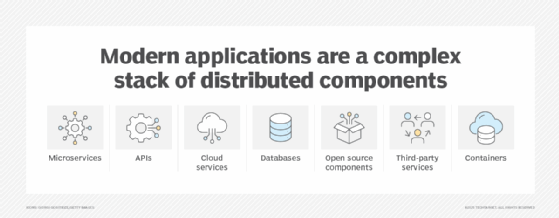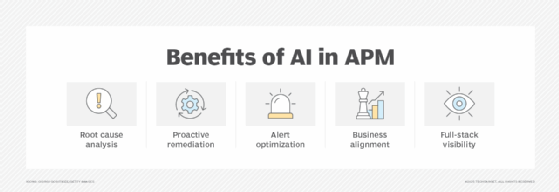Using AI and machine learning for APM
Discover how organizations can streamline operations and improve operational analytics by using AI and machine learning in their application performance monitoring environments.
Organizations are reassessing traditional application performance monitoring and taking a more holistic, tactical approach to acquiring useful operational data. Today, developers and IT operations teams are employing automation, machine learning and other artificial intelligence tools to bridge the gap between traditional APM approaches and new application demands, such as 24/7 availability and constant updates.
Moreover, today's apps comprise microservices, open source components and multiple cloud services, complicating the search for root causes of errors. This article examines how APM can use AI and machine learning (ML) to unlock and enable new application monitoring and protection capabilities. It also explores key implementation steps IT leaders must consider and the future of APM and AI.
AI, APM and end-to-end visibility
Traditional APM relies on monitoring code execution to identify problems, an approach that used to be enough for consistent application performance. However, modern apps typically consist of millions of lines of code, often running in containers. Moreover, these application environments are interconnected and encompass both on-premises and multi-cloud environments. For example, a single application commonly spans dozens of microservices, if not more, in distributed systems.
To further complicate troubleshooting, IT teams must manage a broad spectrum of noncritical components that affect application performance, as well as complex hybrid ecosystems that include Kubernetes orchestrations and innumerable containers. Simply put, single-purpose APM tools lack the integrations necessary for full-stack visibility. To gain the insights they need, IT teams are adopting agile DevOps approaches along with AI and machine learning to handle the sprawl of application components, analyze vast volumes of data and gain actionable insights.
This article is part of
What is APM? Application performance monitoring guide
AI-powered APM systems offer real-time, proactive remediation to resolve performance and availability issues in today's highly complex, modern IT environments. Employing algorithms, analytics and automation to provide comprehensive visibility and map interdependencies, AI can quickly detect and repair issues before IT and DevOps teams are aware that problems exist. For example, using computational power, AI systems can instantly compare different combinations of security layers to pinpoint vulnerabilities in web applications.
The fragmented transaction paths of modern applications make end-to-end visibility nearly impossible without AI and ML capabilities. Moreover, these unstructured data points are too numerous and obscure to be of any use to operations teams. However, machine learning algorithms can mine these vast data stores to pinpoint critical patterns. Through AI adoption, IT teams can find anomalies and quickly resolve performance issues. In addition to data consolidation, AI can automatically observe, correlate and analyze data from multiple sources to improve application performance.

How IT teams combine AI with APM
IT teams can streamline operations, release software faster and deliver better business outcomes by employing AI for full-stack monitoring, root cause analysis (RCA), anomaly detection and continuous automation. By using native AI features, teams can accelerate and simplify management workflows in addition to gaining visibility across infrastructure, networks and users. Administrators can automate processes to make monitoring easier and more reliable, troubleshoot software more quickly and deliver better business outcomes.
For example, team members can apply AI and ML on specific components and perform pattern analysis to gain precise answers and proactively solve issues before they affect performance. The result is more effective microservices and containerized environments. Another critical goal for AI and ML adoption is to avoid overwhelming operational capacity. Teams can generate technical indicators that function as dynamic signals, enabling them to instrument and monitor application KPIs.
They can also use AI to automatically adjust warning thresholds and avoid so-called alert storms triggered by fluctuations in scaling. By providing context, team members can use AI and ML to help them respond to the right alerts quickly and efficiently. Organizations also rely on these technologies to clarify key elements in the relationship between operations and business goals. By identifying repetitive operational patterns, IT teams can uncover the connections between them and extend the value and benefits of AI-enabled APM to help meet projected business outcomes. These include ensuring that all business- and customer-facing applications are efficient and highly responsive.

AI in APM use cases
The combination of AI and ML for improved APM processes offers the following additional capabilities for DevOps teams and IT administrators:
- Root cause analysis. RCA is essential to uncovering performance issues and increasing application longevity. Manual IT analysis is both time-consuming and labor-intensive. AI-enabled APM can accurately pinpoint issues by quickly correlating large volumes of server logs, comparing database queries and analyzing user experience metrics.
- Anomaly detection. AI-driven detection can resolve anomaly issues, such as data latencies, traffic drop-offs or atypical error rates. Organizations benefit from reduced trouble-shooting time, increased system stability/uptime and improved resource allocation.
- Predictive analytics. Predictive analytics uses technical indicators as signals to monitor application consistency over time and to ensure business projections meet their goals. It offers an important feature within AI-powered APM, relying on constant day-to-day data for application performance analysis. AI-driven APM can identify patterns that occur between discrete performance issues to predict and repair anomalies before they cause problems.
- User experience monitoring and optimization. By tracking how users interact with applications and correlating that information with various APM metrics, AI-powered tools can help developers optimize the application design for an improved experience.
Future of AI and APM
Numerous innovations are on the horizon for APM, driven by the need for consistently high application performance. Improved AI capabilities will continue to deliver operational analytics that cover specific APM use cases, whether they extend to network and database monitoring or log, container and user monitoring. Due partly to the demand for advanced tools, various research firms project healthy growth for APM software.
Both machine learning innovations and deep AI analytics promise new levels of visibility and automation that will far exceed simple application debugging and tuning. Generative AI will help resolve software code issues faster and ensure greater application resiliency. New monitoring methods will optimize how users experience software, and enhanced machine-to-machine interactions -- enabled by IoT advances at the edge -- will bring new levels of precision to automation.
Moreover, improved data collection related to telemetry will improve engineering and DevOps tools and ensure more effective end-user capabilities. The transition to distributed services, both in terms of IT infrastructure and applications, will further enhance development and operations, enabling businesses to track the user experience across multiple applications and platforms. Of course, issues around privacy and security will continue to prompt closer scrutiny and vigilance. However, improved AI-powered automation capabilities will enable organizations to more strategically control costs while refining their software deployments.
Editor's note: This article was updated in April 2025 to reflect new developments in using AI and machine learning in APM.
Kerry Doyle writes about technology for a variety of publications and platforms. His current focus is on issues relevant to IT and enterprise leaders across a range of topics, from nanotech and cloud to distributed services and AI.








